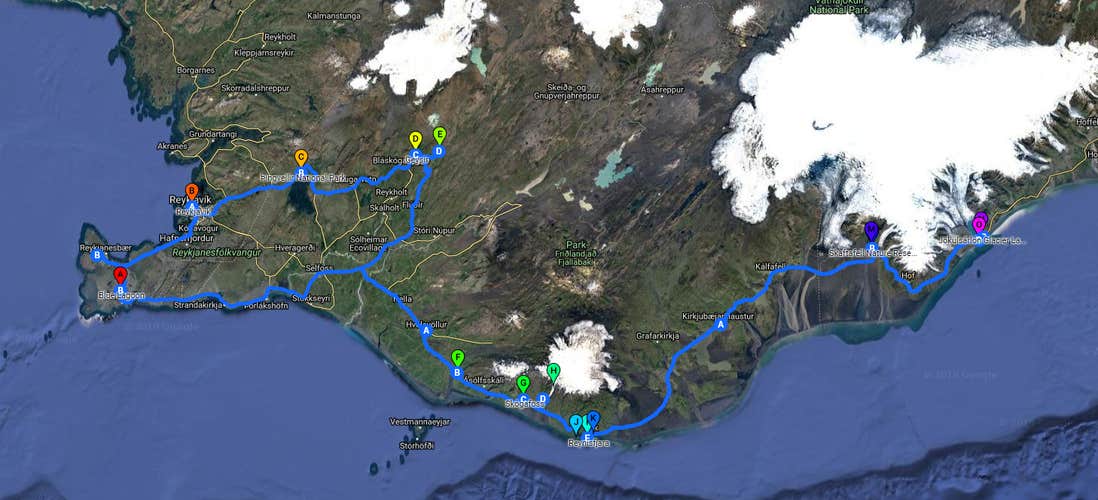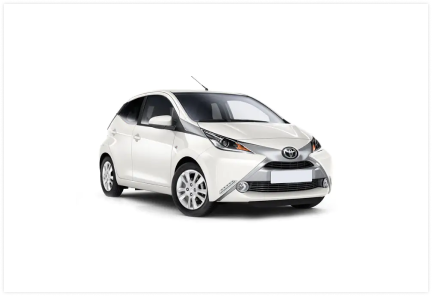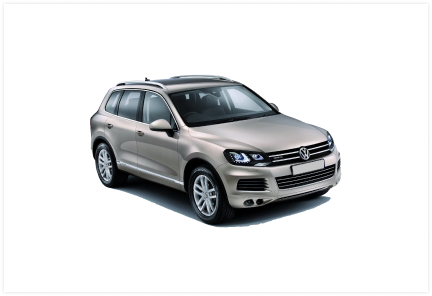Road Trip de 6 jours pour Petits Budgets avec Cercle d'Or & Lagune Glaciaire de Jokulsarlon





Inclus
Destinations
Carte
Lieux phare
Activités
Détails du voyage
Choisissez parmi les meilleurs loueurs de voitures d‘Islande
Choisissez votre moyen de transport dès maintenant ; vous pourrez finaliser les horaires et les détails de prise en charge à mesure que votre voyage approchera.

Citadine

Voiture moyenne

Voiture haut de gamme

large car

SUV
Personnalisez votre itinéraire
Jour 1 – Reykjavík
- Reykjavík - Jour d'arrivée
- Suite
- Reykjavik
- Église Hallgrimskirkja
- Rue Laugavegur
- Sculpture du Sun Voyager
- Salle de Concert Harpa
- Lac Tjörnin
- Vieux Port
- Suite
Votre voyage débute à votre arrivée en Islande. A l'aéroport, vous récupérez votre voiture de location et rejoignez Reykjavik, la capitale islandaise. Une fois installés à votre hébergement, le reste de la journée est libre pour explorer la capitale : promenez-vous dans les rues colorées du centre-ville, découvrez l'église Hallgrímskirkja et le vieux port de la ville. Nuit à Reykjavik.
Hébergement le jour 1
Expériences le jour 1
Jour 2 – Sud-Ouest de l'Islande
- Sud-Ouest de l'Islande
- Suite
- Parc national de Thingvellir
- Laugarvatn
- Cascade de Bruarfoss
- Zone géothermique de Geysir
- Cascade de Gullfoss
- Fludir
- Cratère de Kerid
- Suite
Aujourd'hui, vous pouvez débuter la journée avec la visite de l'intérieur d'un volcan. Ensuite, vous visitez le Cercle d'Or en Islande : route touristique constituée de la cascade Gullfoss, le parc national Thingvellir et Geysir.
Vous débutez avec le parc Thingvellir, lieu de naissance du premier parlement fondé en 930 et haut lieu géologique. Vous visitez ensuite Geysir situé dans la vallée de Haukadalur. Ce site est riche en bains de boue bouillonnants, fumerolles, ainsi que le geyser Strokkur, qui entre en éruption toutes les 8-10 minutes, propulsant de l'eau à plus de 40 m de haut.
Le dernier lieu de la journée est la cascade de Gullfoss. Son nom signifie justement « La Chute d'Or » . Nuit dans la région.
Hébergement le jour 2
Expériences le jour 2
Jour 3 – Côte Sud
- Côte Sud
- Suite
- Cascade Seljalandsfoss
- Cascade de Gljufrabui
- Chute d'Eau de Skogafoss
- Cascade de Kvernufoss
- Le Glacier Solheimajokull
- Dyrholaey
- Plage de sable noir de Reynisfjara
- Formation Rocheuses de Reynisdrangar
- Vik
- Église de Vik i Myrdal
- Suite
Aujourd'hui, vous prenez la route du sud de l'Islande. Depuis la route, vous pouvez apercevoir Eyjafjallajokull, le volcan dont l'éruption en 2010 a fait la une des journaux.
Lors de cette journée, vous visitez les cascades de Seljalandsfoss et de Skogafoss. Vous pouvez également visiter le musée de Skogar sur l'histoire du pays.
Vous découvrez ensuite la plage de Reynisfjara, avec une halte à Vik. Reynisfjara est l'une des plages les plus spectaculaires d'Islande avec son mur de basalte et son sable noir volcanique. Route et nuit dans le village tranquille de Kirkjubæjarklaustur.
Hébergement le jour 3
Expériences le jour 3
Jour 4 – Sud-Est de l'Islande
- Sud-Est de l'Islande
- Suite
- Kirkjubaerklaustur
- Parc National de Vatnajokull
- Réserva Naturelle de Skaftafell
- Cascade de Svartifoss
- Lagune Glaciaire de Fjallsarlon
- Lagune Glaciaire de Jokulsarlon
- Plage de Diamants
- Hofn
- Suite
Vous continuez votre voyage vers le Sud-Est de l'île vers la région du Vatnajokull. En chemin, découvrez la réserve naturelle de Skaftafell, offrant de nombreux sentiers de randonnée dont la randonnée vous menant à la cascade Svartifoss et ses colonnes de basalte. Vous avez également la possibilité de rejoindre une randonnée sur glacier guidée.
Vous reprenez ensuite la route vers Jokulsarlon : une lagune remplie de blocs de glace dérivant lentement vers l'océan. Vous pouvez partir en bateau naviguer parmi ses icebergs. Nuit à Kirkjubaejarklaustur.
Hébergement le jour 4
Expériences le jour 4
Jour 5 – Reykjavík
- Reykjavík
- Suite
- Fjadrargljufur
- Reykjavik
- Suite
Vous reprenez doucement votre route vers l'Ouest de l'île. En cours de route, vous pouvez visiter d'autres sites dont l'avion DC-3 ou la source chaude Seljavallalaug.
Dans l'après-midi, vous visitez la péninsule de Reykjanes avant de vous rendre au Blue Lagoon. Une baignade dans les eaux chaudes turquoises est idéale après un road trip en islande. N'oubliez simplement pas de réserver vos entrées en avance sur leur site internet. Nuit à Reykjavik.
Hébergement le jour 5
Expériences le jour 5
Jour 6 – Reykjavík
- Reykjavík - Jour de départ
- Suite
- Krysuvik
- Piscine Rocheuse Naturelle de Brimketill
- Gunnuhver
- Crête Rocheuse de Valahnukamol
- Phare de Reykjanesviti
- Le Pont entre les Continents
- Falaises Maritimes Hafnarberg
- Suite
Aujourd'hui, vous déposez votre voiture à l'aéroport avant de prendre votre vol international.
Si votre vol est dans l'après-midi ou en soirée, profitez-en pour visiter un peu plus la capitale islandaise.
A bientôt en Islande !
Expériences le jour 6
Comment ça fonctionne
Réservez votre voyage avec l’agence de voyage n°1 en Islande : confirmation immédiate, prix imbattable, assistance locale 24h/24, 7j/7.
Réservez votre place
Recevez une confirmation immédiate
Personnalisez votre itinéraire
Bénéficiez des conseils d’experts
Accédez au Club VIP
Voyagez l’esprit tranquille
À emporter avec vous
Bon à savoir
Les circuits en autotour commencent soit à Reykjavík, soit à l'aéroport international de Keflavik. Un permis de conduire valide est requis, ainsi qu'une expérience d'un an sur route. La protection contre le gravier n'est pas incluse si vous choisissez une Toyota Aygo ou une voiture similaire.
Veuillez noter que votre itinéraire peut être modifié pour mieux correspondre à votre date et heure d'arrivée.
Bien que ce soit l'été, le climat islandais peut être très imprévisible. Veuillez apporter des vêtements appropriés.
Il est interdit de porter du coton ou un jean comme couche extérieure pendant l'excursion au volcan Þríhnjúkagígur. Veuillez porter des vêtements imperméables et des chaussures de randonnée robustes pour cette excursion. La température à l'intérieur du cratère est toujours la même — environ 5-6° C. La visite du volcan Þríhnjúkagígur implique une randonnée d'environ 3 km dans chaque sens. La marche dure généralement de 45 à 50 minutes (en fonction des conditions physiques des personnes du groupe). Un guide vous accompagnera tout au long de la marche.
Pour l'excursion de plongée avec tuba, les participants doivent être à l'aise dans l'eau et savoir nager.
Vidéo
Nous garantissons
Votre voyage est protégé, personnalisé et au juste prix. Aucune surprise, aucun stress.
Avis vérifiés
Forfaits de voyage similaires

Téléchargez la plus grande plateforme de voyage d'Islande sur votre téléphone pour gérer l'intégralité de votre voyage au même endroit
Scannez ce code QR avec l'appareil photo de votre téléphone, et cliquez sur le lien apparaissant pour avoir la plus grande plateforme de voyage d'Islande à portée de main. Ajoutez votre numéro de téléphone ou votre adresse e-mail pour recevoir un SMS ou un e-mail avec le lien de téléchargement.







